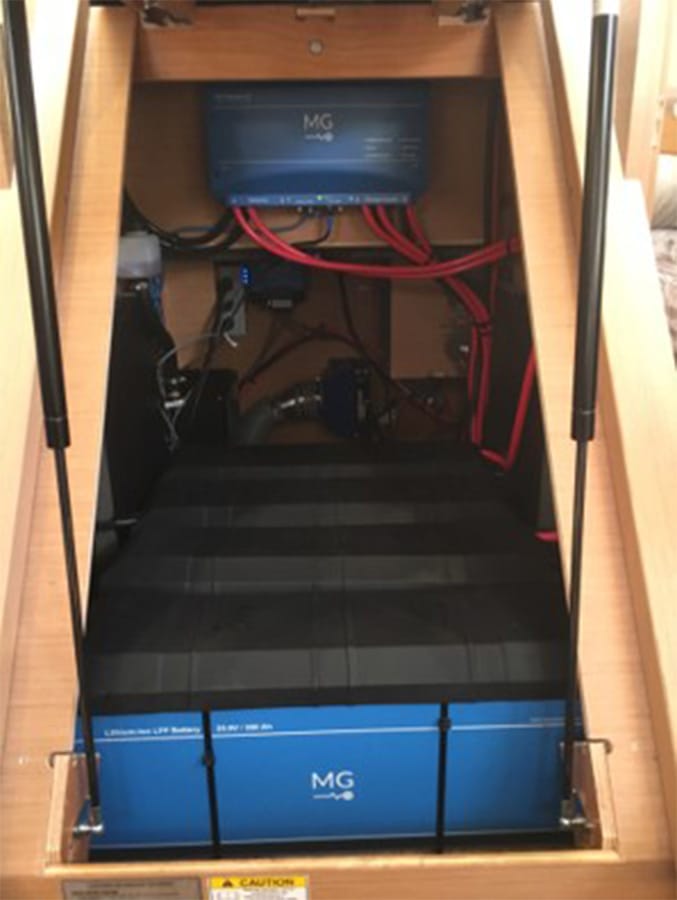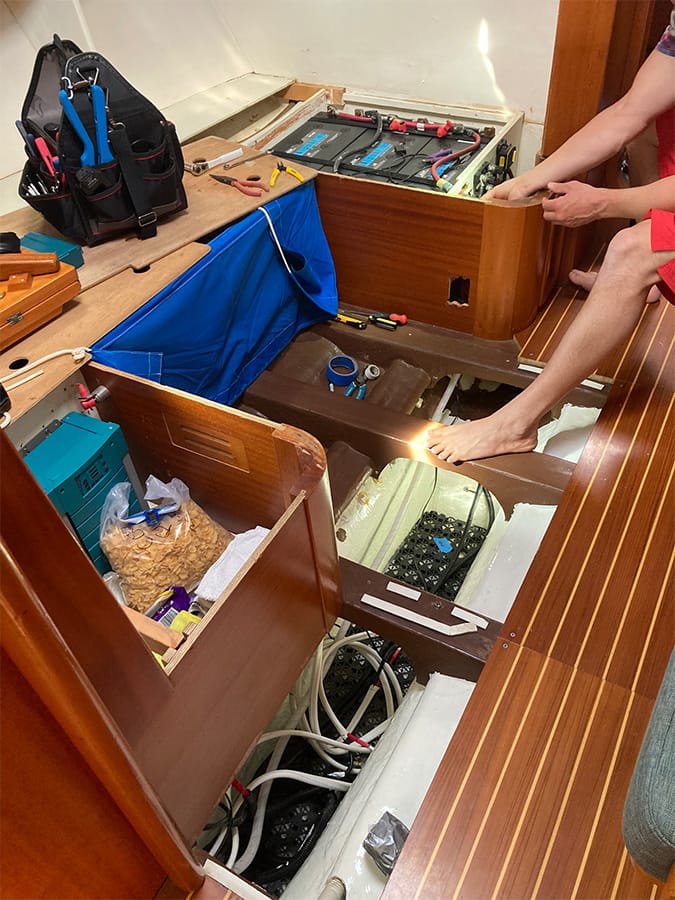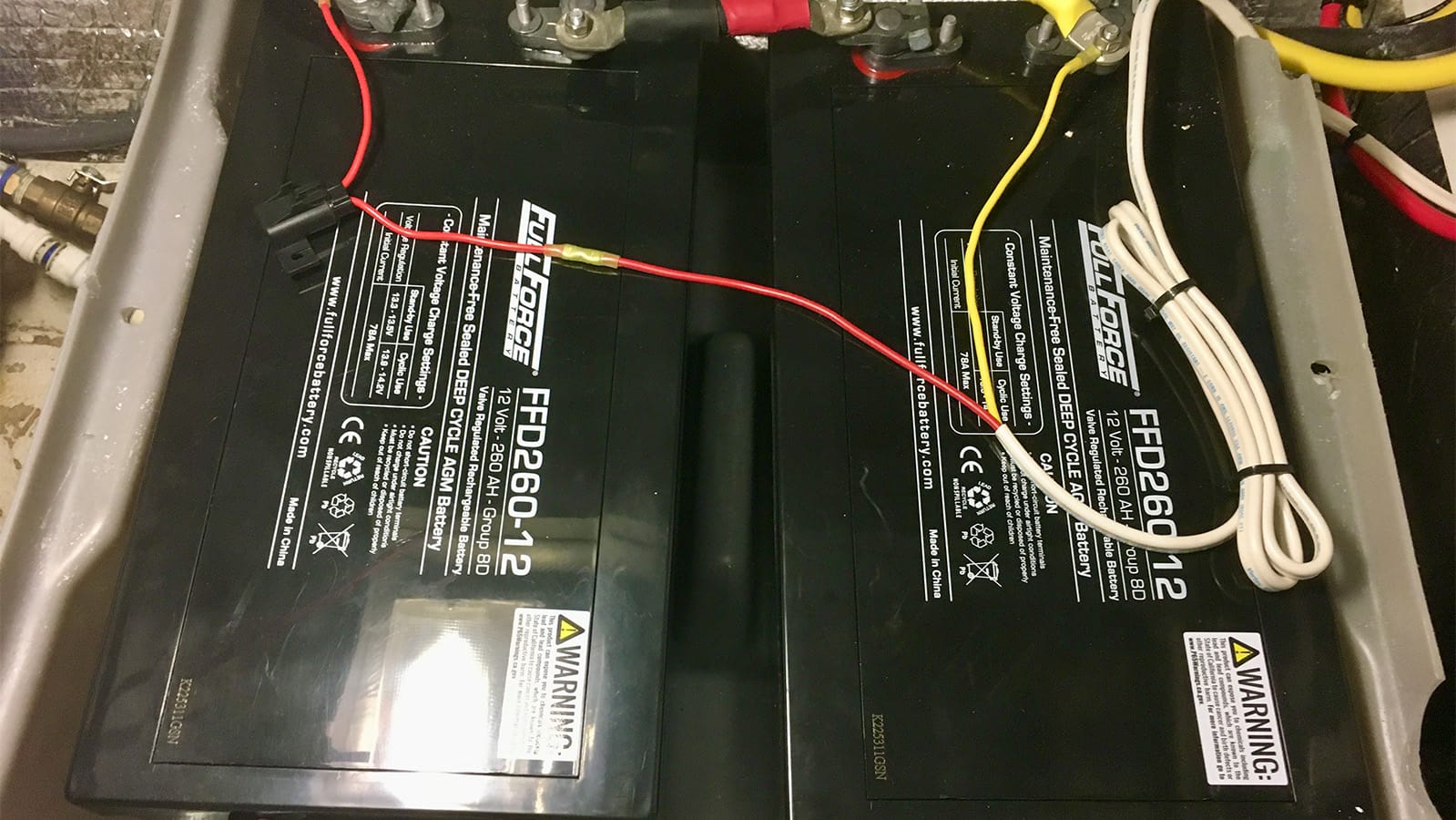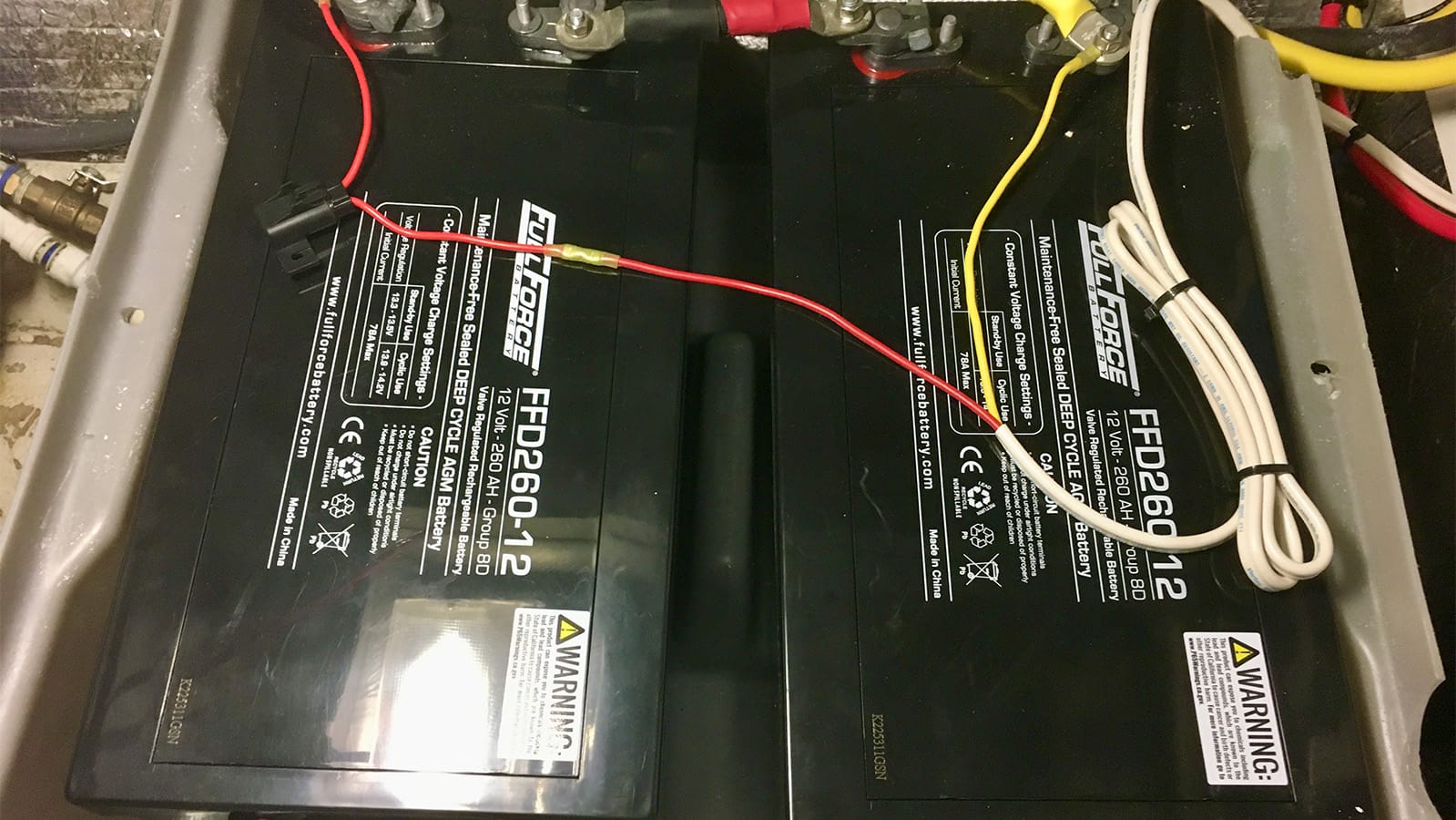By Gio & Julie Cappelli, Pelagic Blue
Estimated reading time: 8-10 minutes
Table of contents
- 1. Understand Your Battery’s Unique Needs
- 2. Avoid Overloading Your System
- 3. Charge Properly and Consistently
- 4. Protect Against Corrosion, Dirt, and Heat
- 5. Monitor Performance Regularly
- 6. Plan for Seasonal or Long-Term Storage
- 7. Avoid Common Mistakes and Myths
- 8. Why This Matters for Cruisers
- About the Author s
- Join The Discussion
Your boat’s batteries are the heart of your electrical system. From powering navigation lights and refrigeration to running communication equipment and onboard comforts, healthy batteries and battery banks keep you safe, comfortable, and independent both at sea and at anchor. And while choosing the right battery chemistry that matches your unique power needs, understanding how to care for your batteries is just as important. With proper maintenance, monitoring, and charging practices, you can significantly extend the lifespan of your batteries, avoid unnecessary replacements, and prevent unexpected power failures during critical moments offshore.
In this article, we’ll walk through practical strategies, real-world examples, and key tips to make sure your batteries perform optimally, whether you’re intending to hop down the coast or set sail on extended offshore passages.
1. Understand Your Battery’s Unique Needs
Different battery chemistries have different requirements. Lead-acid batteries, which include both flooded and AGM types, respond poorly to repeated deep discharges or irregular charging. Flooded lead-acid batteries also require periodic electrolyte checks and water top-ups, whereas AGM and gel batteries are sealed but still sensitive to charging voltage and temperature extremes. Lithium batteries are largely maintenance-free but do require compatible charging systems to maintain performance and longevity.
A practical way to stay ahead of battery issues in this manner is to keep a detailed log of their output and performance. Record voltage readings, charging cycles, and seasonal usage patterns, and review your log regularly. Tracking this information makes it easier to notice declining capacity or irregularities, allowing you to address potential problems before they turn into emergencies.
A recent client of ours began regularly checking his battery monitor for the first time since purchasing his cruising boat. He kept a basic battery log and quickly discovered something surprising: his battery monitor wasn’t actually connected to the battery he thought it was tracking. By comparing his notes with the readings, he realized the numbers didn’t add up. That simple habit of logging helped him catch the mistake early, ensuring he had accurate information about his system and preventing confusion that could have led to serious power problems down the line.
2. Avoid Overloading Your System

A modern lithium battery installation. Compact, efficient, and low-maintenance, designed for long-term cruising reliability.
Every electrical system has limits. Running multiple high-draw devices simultaneously – like heaters, refrigeration, navigation systems, and water pumps – can stress your batteries, particularly if they are smaller, older, or out of optimal temperature range. Overloading can lead to deep discharges, which significantly shorten the life of lead-acid batteries and will also reduce lithium capacity over time, just not quite as precipitously.
A smart habit for managing onboard energy is to create a “power map” of your boat. By identifying which devices draw the most power, you can plan your usage more strategically. For instance, staggering refrigeration cycles, avoiding running heaters at full output while charging electronics, and keeping a close eye on inverter use can all help balance demand and prevent overloading your system.
One cruiser we worked with relied on an InstaPot for most of their cooking, not realizing how much energy it consumed compared to a stovetop pressure cooker. On passage, the heavy power draw quickly drew their batteries down, especially when combined with other loads. Once they saw the pattern in their power use, they switched to the stovetop version for long trips and saved the InstaPot for times when they had plenty of charging capacity. This allows them to continue keeping meals hot and ready without draining their batteries and without having to stop cruising mid-season to upgrade their electrical system.
3. Charge Properly and Consistently
Proper charging is essential for battery health. Different battery types require different charging strategies:
- Lead-Acid Batteries (Flooded, AGM, Gel): Typically need a three-stage charger (bulk, absorption, float). Overcharging can boil electrolyte in flooded cells, and undercharging leads to sulfation, which reduces capacity.
- Lithium Batteries: Require chargers compatible with lithium voltage parameters and temperature compensation. Full charging or discharging outside recommended limits can reduce lifespan.
Tips for Consistent Charging:
- Invest in a smart multi-stage charger.
- Consider alternator charging while underway, but monitor voltage carefully.
- Use solar or wind generation to maintain charge when at anchor.
- Avoid leaving batteries partially charged for long periods.
Battery monitors and shunt systems are valuable tools for keeping tabs on your energy use, providing real-time information on voltage, state of charge, and electrical loads. Many modern monitors go a step further, tracking amp-hours consumed, estimating remaining capacity, and even storing historical performance trends – giving you a clearer picture of how your batteries are performing over time.
4. Protect Against Corrosion, Dirt, and Heat
Environmental factors can quietly degrade battery performance. Corrosion at terminals, loose or improperly installed terminations (aka connections), and dirt on battery surfaces reduce efficiency and can cause failure. Heat also accelerates chemical reactions inside batteries, shortening their lifespan, particularly for lead-acid types.
Tips for Protection:
- Inspect terminals monthly; clean and apply corrosion inhibitor.
- Ensure all connections are properly installed and tight.
- Install insulation or ventilation if your engine compartment or battery storage area is hot.
- Keep batteries away from direct sunlight or other heat sources.
5. Monitor Performance Regularly

Inspecting and servicing a boat’s battery bank. Regular checks like these prevent corrosion, ensure proper connections, and extend battery life.
Battery degradation often happens gradually. Dimmer lights, slower engine starts, or reduced inverter performance are signs of declining capacity. Regular monitoring helps catch these issues early.
What You Can Do:
- Check voltage at least once a month.
- Track charge cycles and capacity if possible.
- Inspect and test each battery individually on multi-battery systems.
- Modern monitors with alarms can prevent accidental deep discharge.
Here’s a pro tip that pays off over the long term: keep a simple “battery health log” in your cruising notebook. Each time you check your system, jot down voltage readings, the charging method you used – whether solar, alternator, or shore power – and any significant load events, like running the watermaker or inverter. Over time, these notes create a valuable record that reveals patterns in your energy use and battery behavior. With that insight, you can spot declining performance early, fine-tune your charging strategy, and make better decisions about when to conserve or when to push your system harder. It’s a small habit that can extend battery life and prevent costly surprises.
6. Plan for Seasonal or Long-Term Storage
Batteries left discharged, exposed to extreme temperatures, or without a maintenance charger will lose capacity quickly. Proper storage depends on battery chemistry:
- Lead-Acid Batteries: Store fully charged and top off electrolyte if flooded. Use a float charger to maintain voltage.
- Lithium Batteries: Avoid full charge or deep discharge storage for long periods; ideally store and charge in a cool, dry place.
For boats laid up in storage or during the off-season, it’s important to think about how your batteries are cared for. If practical, remove them from the boat entirely and store them in a dry, temperature-stable location where they can be inspected and maintained more easily. If removal isn’t feasible, the next best step is to connect a smart charger. These devices keep batteries at an appropriate charge level without overcharging, preventing the slow self-discharge that can damage them over time. Either approach helps ensure your batteries are healthy and ready when the next cruising season begins.
7. Avoid Common Mistakes and Myths
- Myth: “Lead-acid batteries last forever if I don’t over-discharge them.” Reality: Even without heavy use, improper charging or heat can shorten life.
- Mistake: Relying on voltage alone as a measure of battery health. Voltage is useful but doesn’t tell the full story of capacity or internal resistance.
- Mistake: Neglecting to balance battery banks. Unevenly charged batteries in a multi-battery system can reduce overall lifespan.
Pro Tip: Take the time to understand your boat’s electrical system, and monitor each battery individually. Keeping track of the performance of each battery helps you spot issues early, prevents unexpected failures, and ensures you always have a reliable power reserve when you need it most.
8. Why This Matters for Cruisers
Battery health is so much more than a technical concern. In reality, it comes down to your safety, comfort, and independence at sea. A well-maintained battery bank ensures critical systems work when you need them most, especially offshore. Proper care reduces costs, minimizes risk, and keeps your boat ready to sail anytime.
In our online class on boat batteries, we teach sailors how to:
- Calculate true electrical load for their boats
- Optimize charging strategies for each battery type
- Maintain batteries in real-world cruising conditions
- Plan for seasonal storage and long-term reliability
Whether you’re cruising locally or planning extended offshore passages, understanding how to maximize battery performance is essential. With proper care and monitoring, your batteries will serve reliably for years, keeping your boat powered, safe, and ready for adventure.
Join Gio and Julie as they cover the Boat Battery Basics in our online course taking place November 4th and 11th. In this online class, Gio and Julie Cappelli will guide you through the essentials of battery knowledge and care for cruising sailors. Starting with the basics of how batteries fit into AC and DC systems, you’ll learn about different battery types, their construction, and how to evaluate their health. From wiring considerations and safety features to practical tips on charging and extending battery life, you’ll gain the knowledge to make informed decisions and prevent costly mistakes. By the end, you’ll feel more confident in keeping your battery bank strong and your boat powered up—wherever the wind takes you.
About the Authors
Gio and Julie Cappelli took a “seabattical” from their careers as marine biologists in 2021 and opted not to return to terrestrial life. They’ve since graduated from Skagit Valley College’s Marine Maintenance Technology program, earned ABYC and NMEA certifications, and are USCG Masters. They’ve sailed 30,000 miles through the Pacific, plus 10,000 miles as expedition staff on National Geographic-Lindblad Expeditions ships in Alaska, British Columbia, and Washington. They lead sail training expeditions in their favorite places across the globe that focus on preparing students for safe and comfortable bluewater cruising on their own boats. In addition to running Pelagic Blue, they teach offshore cruising workshops and classes with John Neal of Mahina Offshore Services and the American Sailing Association (ASA). When not at sea they enjoy hiking, fishing, planning their next cruise, and helping their clients prepare to set sail.ocean on the planet. There are about 94 currently recognized species and so far, she’s got 18!

Join The Discussion
-
How Do You Maximize Your Boat Battery’s Lifespan?
Posted by American Sailing on October 21, 2025 at 1:35 pmWhether you’re using lead-acid, AGM, or lithium batteries, what methods have helped you get the most life out of your battery bank?
Do you keep a log, use smart monitoring tools, or have a favorite charging strategy?
Share your setup, lessons learned, and any tips for maintaining reliable power while cruising! ⚡️
Gio & Julie Cappelli of Pelagic Blue covers smart maintenance practices in our latest article. From understanding different battery types to managing charging cycles, storage, and system loads. Read the Full article here:
-
This discussion was modified 1 month, 1 week ago by
 Phaedra.
Phaedra.
-
This discussion was modified 1 month, 1 week ago by
 Phaedra.
Phaedra.
americansailing.com
How to Extend Your Boat Battery's Lifespan
How to Extend Your Boat Battery’s Lifespan. Smart maintenance, charging, and monitoring tips from cruising experts Gio and Julie Cappelli.
American Sailing replied 1 month, 2 weeks ago 1 Member · 0 Replies -
This discussion was modified 1 month, 1 week ago by
-
0 Replies
Sorry, there were no replies found.
Log in to reply.










